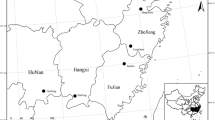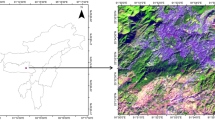Abstract
Variation of vegetation coverage and canopy height may reflect the complex spatial heterogeneity of nutrient storage and supply capacity, soil moisture, and surface hydrology in the karst terrains suffering from severe land degradation. To assess the patterns of nutrient limitation under different vegetation covers in the subtropical karst ecosystems from Guizhou province, southwestern China, topsoil and leaf samples of dominant tree species were collected in forest stand (FO), shrub stand (SH) and shrub-grass stand (SG), respectively. Nutrient concentrations of both soil and leaf were determined, and ratios of N to P and vegetation nutrient reuse capacity (VNR) calculated as well as vegetation coverage, vegetation canopy height and tree density measured across the three stands. Mean leaf N/P ratio was lowest (16.1 ± 1.4) in FO and highest (33.5 ± 3.2) in SG. Vegetation nutrient reuse increased with the decline in N and P availability in soils for these three stands. VNR of N and P ranged from 8.5 to 25.2 mg N g−1 and from 0.4 to 1.1 mg P g−1, respectively, and appeared lowest in SG (10.4 mg N g−1 and 0.5 P mg g−1 on average, respectively) and highest in FO (22.4 mg N g−1 and 0.9 mg P g−1 on average, respectively). Although there was no substantial difference in phosphorus reuse efficiencies between plant species and vegetation stands, concentrations of N and P of senesced leaves (SLs) were, respectively, found in positive correlation with the concentrations of mature leaves. The variation of VNR with elements indicated that P is cycled within vegetation much more efficiently than N across the stands. This study demonstrated that the karst vegetations were generally at P-limited or N- and P- co-limited stresses and that N/P ratio could be an effective indictor for nutrient limitation in the karst ecosystems at vegetation community level rather than at tree species level. It is proposed that phosphorus reuse by mature leaves could be an adaptation strategy by the dominant species to the low P availability in the karst soil.




Similar content being viewed by others
References
Aerts R (1996) Nutrient reuse from senescing leaves of perennials: are there general patterns? J Ecol 84:597–608
Aerts R, Chapin FS III (1999) The mineral nutrition of wild plants revisited: a re-evaluation of processes and patterns. Adv Ecol Res 30:1–67
Alonso C, Herrera CM (2003) Developmental and spatial co-variation of nutrients in growing leaves of Daphne laureola and their relationships with herbivory. New Phytol 159:645–656
Asner GP, Martin RE, Ford AJ, Metcalfe DJ, Liddell MJ (2009) Leaf chemical and spectral diversity in Australian tropical forests. Ecol Appl 19:236–253
Baer SG, Blair JM, Collins SL, Knapp AK (2004) Plant community responses to resource availability and heterogeneity during restoration. Oecologia 139:617–629
Boeye D, Verhagen B, van Haesebroeck V, Verheyen RF (1997) Nutrient limitation in species-rich lowland fens. J Veg Sci 8:415–424
Chapin FS III, Kedrowski RA (1983) Seasonal changes in nitrogen and phosphorus fractions and autumn retranslocation in evergreen and deciduous taiga trees. Ecology 64:376–391
Collins B, Wein G (1998) Soil resource heterogeneity effects on early succession. Oikos 82:238–245
Drenovsky RE, Richards JH (2004) Critical N:P values: predicting nutrient deficiencies in desert shrublands. Plant Soil 259:59–69
Enriquez S, Duarte CM, Sand-Jensen K (1993) Patterns in decomposition rates among photosynthetic organisms: the importance of detritus C:N:P content. Oecologia 94:457–471
Escudero A, del Arco JM, Sanz IC, Ayala J (1992) Effects of leaf longevity and retranslocation efficiency on the retention time of nutrients in the leaf biomass of different wood species. Oecologia 90:80–87
Feller IC, Mckee KL, Whigham DF, O’Neill JP (2002) Nitrogen vs. phosphorus limitation across an ecotonal gradient in a mangrove forest. Biogeochemistry 62:145–175
Finzi AC, van Breemen NC, Canham CD (1998) Canopy tree–soil interactions within temperate forests: species effects on soil carbon and nitrogen. Ecol Appl 8:440–446
Gao SP, Li JX, Xu MC, Chen X, Dai J (2007) Leaf N and P stoichiometry of common species in successional stages of the evergreen broad-leaved forest in Tiantong National Forest Park, Zhejiang province, China. Acta Ecol Sinica 27:947–952 (in Chinese with English abstract)
Grime JP (1998) Benefits of plant diversity to ecosystems: immediate, filter and founder effects. J Ecol 86:902–910
Güsewell S (2004) N:P ratios in terrestrial plants: variation and functional significance. New Phytol 164:243–266
Güsewell S, Koerselman W (2002) Variation in nitrogen and phosphorus concentrations of wetland plants. Evol Syst 5:37–61
Hofmeister J, Mihaljeviě M, Hošek J, Sádlo J (2002) Eutrophication of deciduous forests in the Bohemian Karst (Czech Republic): the role of nitrogen and phosphorus. For Ecol Manage 169:213–230
Hu ZL, Pan GX, Li LQ, Du YX, Wang XZ (2009) Changes in pools and heterogeneity of soil organic carbon, nitrogen and phosphorus under different vegetation types in Karst mountainous area of central Guizhou Province, China. Acta Ecol Sinica 29:1–9 (in Chinese with English abstract)
Killingbeck KT (1996) Nutrients in senesced leaves: keys to the search for potential reuse and reuse proficiency. Ecology 77:1716–1727
Kobe RK, Lepczyk CA, Iyer M (2005) Reuse efficiency decreases with increasing green leaf nutrients in a global data set. Ecology 86:2780–2792
Koerselman W, Meuleman AFM (1996) The vegetation N:P ratio: a new tool to detect the nature of nutrient limitation. J Appl Ecol 33:1441–1450
Lajtha K, Klein M (1988) The effect of varying nitrogen and phosphorus availability on nutrient use by Larrea tridentata, a desert evergreen shrub. Oecologia 75:348–353
Lal CB, Annapurna C, Raghubanshi AS, Singh JS (2001) Effects of leaf habit and soil type on nutrient reuse and conservation in woody species of a dry tropical environment. Can J Bot 79:1066–1075
Liu F, Wang SJ, Luo HB, Liu YS, He TB, Long J (2006) Vegetation succession with Karst desertification and its impact on water chemistry of runoff. Acta Pedol Sinica 43:26–32 (in Chinese with English abstract)
Liu XY, Xiao HY, Liu CQ, Xiao HW (2008) Deposition mechanism and distribution of the domination atmospheric N sources in Guizhou area: evidences from tissue N and δ15N in epilithic mosses of moss. Geochimica 37:455–461 (in Chinese with English abstract)
Lu RK (2000) Methods of soil and agro-chemical analysis. China Agricultural Science and Technology Press, Bejing, pp 31–40, 80–85 (in Chinese)
Lu XQ, Fang SZ (2008) Studies on the early growth and dynamics of leaf nutrient of eight tree species in Karst mountain area of Guizhou Province. J Nanjing For Univ (Natural Sciences Edition) 32:38–42 (in Chinese with English abstract)
Niinemets Ü, Kull K (2005) Co-limitation of plant primary productivity by nitrogen and phosphorus in a species-rich wooded meadow on calcareous soils. Oecologica 28:345–356
Olde Venterink H, Wassen MJ, Verkroost AWM, De Ruiter PC (2003) Species richness-productivity patterns differ between N-, P-, and K-limited wetlands. Ecology 84:2191–2199
Origin Lab Co (2009) Origin 7.0 software package, Northampton, MA, USA
Piao HC, Liu CQ, Zhu SF, Zhu JM (2005) Variations of C4 and C3 plant N:P ratios influenced by nutrient stoichiometry in limestone and sandstone areas of Guihzou. Quat Sci 25:553–560 (in Chinese with English abstract)
Porder S, Vitousek PM, Chadwick OA, Chamberlain CP, Hilley GE (2007) Uplift, erosion, and phosphorus limitation in terrestrial ecosystems. Ecosystems 10:158–170
Ratnam J, Sankaran M, Hanan NP, Grant RC, Zambatis N (2008) Nutrient reuse patterns of plant functional group in a tropical savanna: variation and functional significance. Oecologia 157:141–151
Ren JC, Zhang PJ, Pan GX, Song LH (2006) Indices of eco-geochemical characteristics in a degradation-reclamation sequence of soils in mountainous karst area: a case study in Guangling-Zhenfeng region, Guizhou, China. Adv Earth Sci 21:504–512 (in Chinese with English abstract)
Richardson SJ, Peltzer DA, Allen RB, McGlone MS, Parfitt RL (2004) Rapid development of phosphorus limitation in temperate rainforest along the Franz Josef soil chronosequence. Oecologia 139:267–276
Rivera LW, Aide TM (1998) Forest recovery in the karst region of Puerto Rico. For Ecol Manage 108:63–75
Schlesinger WH, DeLucia EH, Billings WD (1989) Nutrient-use efficiency of woody plants on contrasting soils in the western Great Basin. Nevada Ecol 70:105–113
SPSS Inc (2009) SPSS for Windows, version 17.0, Chicago, IL, USA
Tessier JT, Raynal DJ (2003) Use of nitrogen to phosphorus ratios in plant tissue as an indicator of nutrient limitation and nitrogen saturation. J Appl Ecol 40:523–534
Tyler G (1996) Soil chemical limitations to growth and development of Veronica officinalis L. and Carex pilulifera L. Plant Soil 184:281–289
van Heerwaarden LM, Toet S, Aerts R (2003) Current measures of nutrient reuse efficiency lead to a substantial underestimation of real reuse efficiency: facts and solutions. Oikos 101:664–669
Vitousek PM (1982) Nutrient cycling and nutrient use efficiency. Am Nat 119:553–572
Vitousek PM (1998) Foliar and litter nutrients, nutrient reuse, and decomposition in Hawaiian Metrosideros polymorpha. Ecosystems 1:401–407
Wright IJ, Westoby M (2003) Nutrient concentration, reuse and lifespan: leaf traits of Australian sclerophyll species. Funct Ecol 17:10–19
Yuan DX (2001) On the karst ecosystem. Acta Geol Sinica 75(3):336–338
Yuan ZY, Li LH, Han XG, Huang JH, Jiang GM, Wan SQ, Zhang WH, Chen QS (2005) Nitrogen reuse from senescing leaves in 28 plant species in a semi-arid region of northern China. J Arid Environ 63:191–202
Acknowledgments
The research project was financially supported by the Major State Basic Research Program of People’s Republic of China (No. 2006CB403205). Thanks to professor, Dr Andrew Chang from the Department of Environmental Sciences, University of California Riverside, USA for his help in smoothing the English editing of this manuscript.
Author information
Authors and Affiliations
Corresponding author
Rights and permissions
About this article
Cite this article
Du, Y., Pan, G., Li, L. et al. Leaf N/P ratio and nutrient reuse between dominant species and stands: predicting phosphorus deficiencies in Karst ecosystems, southwestern China. Environ Earth Sci 64, 299–309 (2011). https://doi.org/10.1007/s12665-010-0847-1
Received:
Accepted:
Published:
Issue Date:
DOI: https://doi.org/10.1007/s12665-010-0847-1




